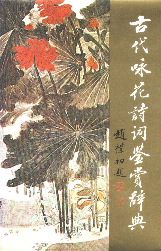古代咏花诗词鉴赏辞典
李文禄等主编,吉林大学出版社1990年3月出版。32开,1523页。

主要责任者: 李文禄,刘维治
责任方式: 主编
出版者: 吉林大学出版社
出版地: 长春
字数: 1899 千字
页码: 1-1523
开本: 32
装帧: 精
语种:中
定价:29.50
出版时间:1990-08
丛书多卷书否:否
书目简介:本册工具书共收录1299条词条。
被引频次:46
| 词条 | 古代咏花诗词鉴赏辞典 |
| 类别 | 中文百科知识 |
| 释义 | 古代咏花诗词鉴赏辞典李文禄等主编,吉林大学出版社1990年3月出版。32开,1523页。  主要责任者: 李文禄,刘维治 责任方式: 主编 出版者: 吉林大学出版社 出版地: 长春 字数: 1899 千字 页码: 1-1523 开本: 32 装帧: 精 语种:中 定价:29.50 出版时间:1990-08 丛书多卷书否:否 书目简介:本册工具书共收录1299条词条。 被引频次:46 |
| 随便看 |
开放百科全书收录579518条英语、德语、日语等多语种百科知识,基本涵盖了大多数领域的百科知识,是一部内容自由、开放的电子版国际百科全书。